Comprehensive Operational Plan Report: Coffee Mug Cafe, 2017
VerifiedAdded on 2020/05/11
|15
|2538
|142
Report
AI Summary
This report presents a comprehensive operational plan for the Coffee Mug Cafe, a proposed coffee shop located in the Launceston Transit Centre, Tasmania. The report begins with a detailed business description, including key performance indicators, legal form, and location details, emphasizing the cafe's offerings of various coffee types, pastries, and operating hours. It then outlines the organizational structure, detailing the management team, key personnel, and their roles. The report further delves into human resource management, covering recruitment, training, promotion, and remuneration strategies. The operational production plan includes production facilities, intellectual property protection, and a weekly operations flow chart. Finally, the report provides a capital and operational expenditure analysis, including sources of capital, start-up costs, and assets. The report is a complete business plan for the cafe including all the important aspects of its operation and financial details.
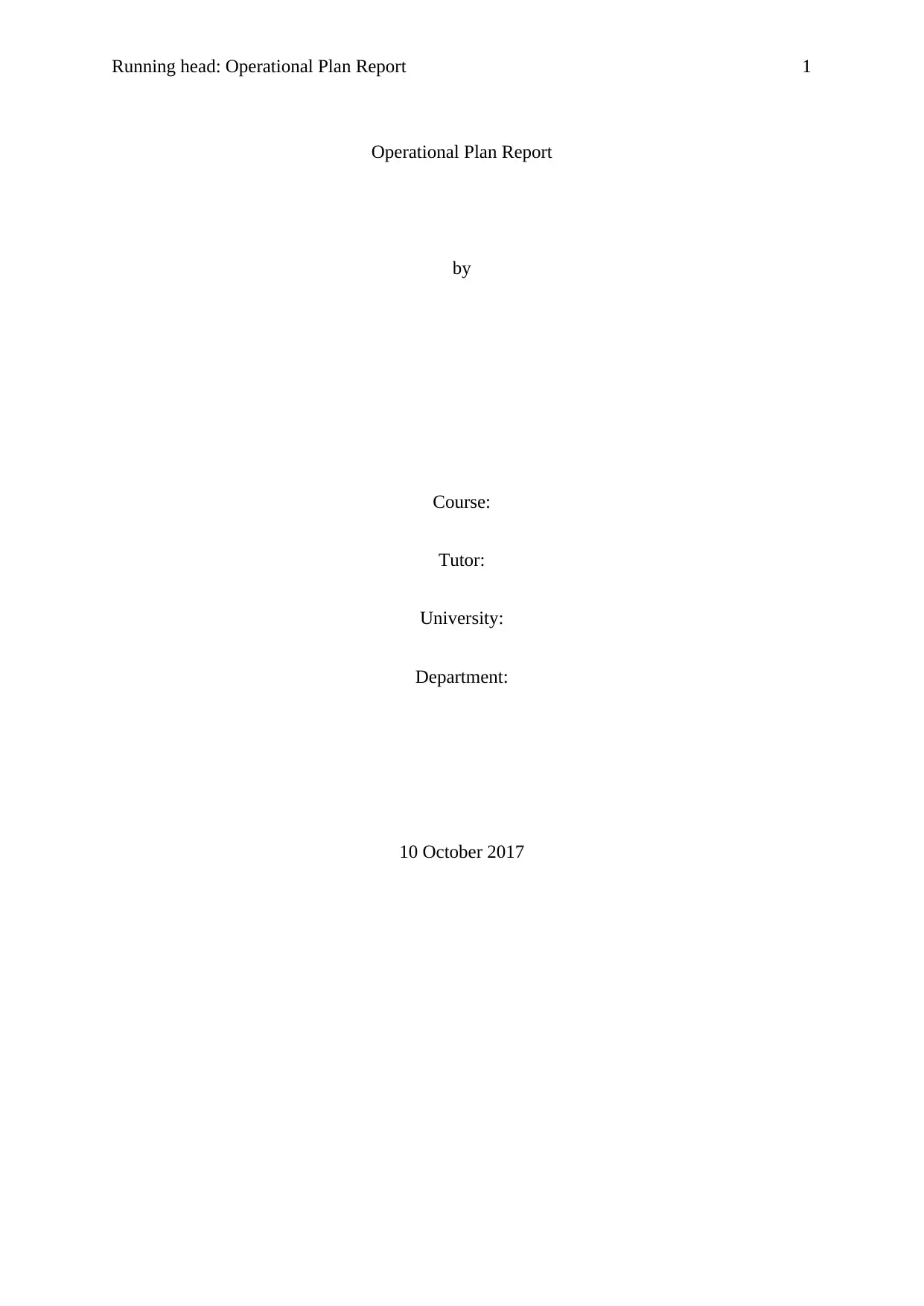
Running head: Operational Plan Report 1
Operational Plan Report
by
Course:
Tutor:
University:
Department:
10 October 2017
Operational Plan Report
by
Course:
Tutor:
University:
Department:
10 October 2017
Paraphrase This Document
Need a fresh take? Get an instant paraphrase of this document with our AI Paraphraser
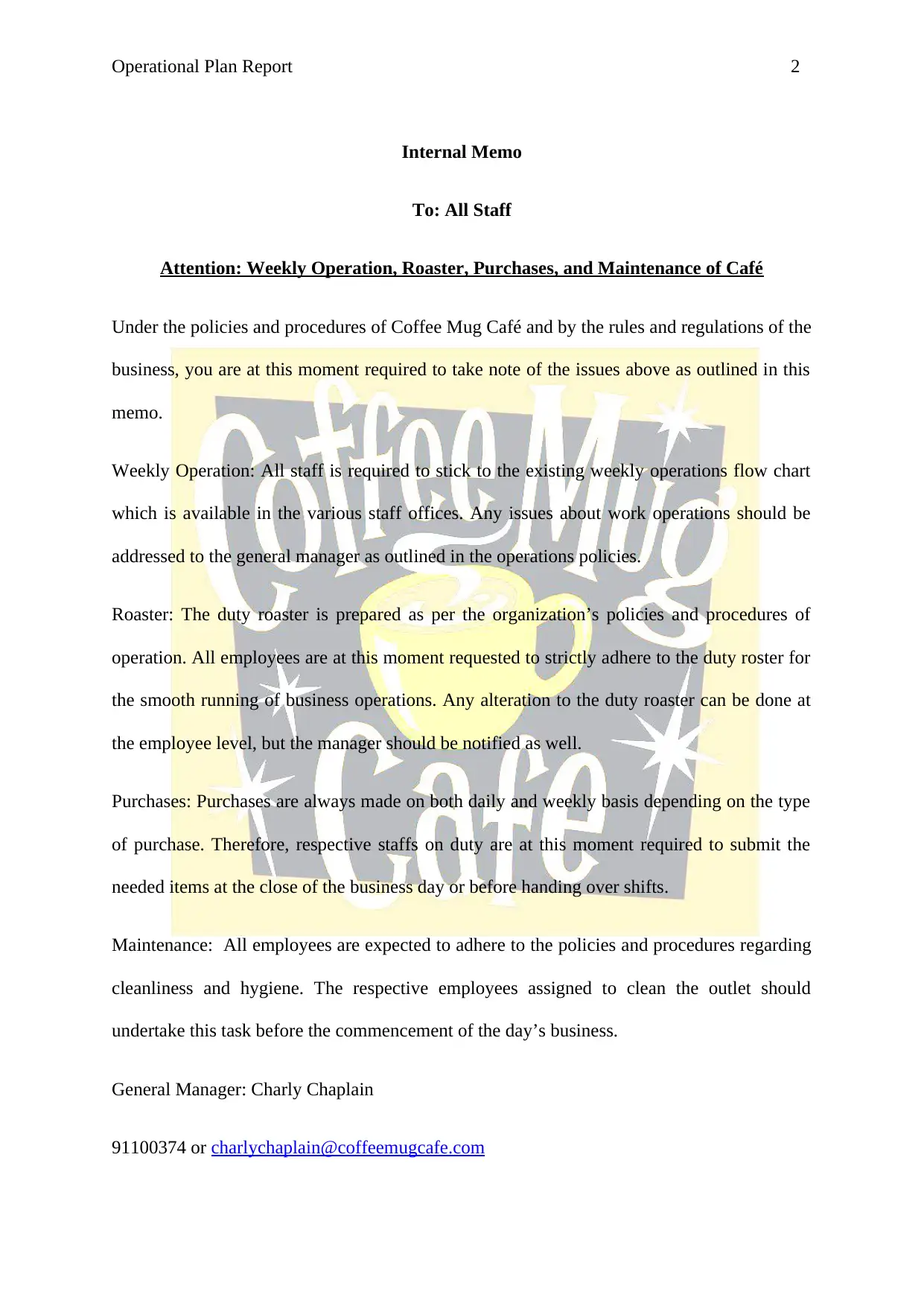
Operational Plan Report 2
Internal Memo
To: All Staff
Attention: Weekly Operation, Roaster, Purchases, and Maintenance of Café
Under the policies and procedures of Coffee Mug Café and by the rules and regulations of the
business, you are at this moment required to take note of the issues above as outlined in this
memo.
Weekly Operation: All staff is required to stick to the existing weekly operations flow chart
which is available in the various staff offices. Any issues about work operations should be
addressed to the general manager as outlined in the operations policies.
Roaster: The duty roaster is prepared as per the organization’s policies and procedures of
operation. All employees are at this moment requested to strictly adhere to the duty roster for
the smooth running of business operations. Any alteration to the duty roaster can be done at
the employee level, but the manager should be notified as well.
Purchases: Purchases are always made on both daily and weekly basis depending on the type
of purchase. Therefore, respective staffs on duty are at this moment required to submit the
needed items at the close of the business day or before handing over shifts.
Maintenance: All employees are expected to adhere to the policies and procedures regarding
cleanliness and hygiene. The respective employees assigned to clean the outlet should
undertake this task before the commencement of the day’s business.
General Manager: Charly Chaplain
91100374 or charlychaplain@coffeemugcafe.com
Internal Memo
To: All Staff
Attention: Weekly Operation, Roaster, Purchases, and Maintenance of Café
Under the policies and procedures of Coffee Mug Café and by the rules and regulations of the
business, you are at this moment required to take note of the issues above as outlined in this
memo.
Weekly Operation: All staff is required to stick to the existing weekly operations flow chart
which is available in the various staff offices. Any issues about work operations should be
addressed to the general manager as outlined in the operations policies.
Roaster: The duty roaster is prepared as per the organization’s policies and procedures of
operation. All employees are at this moment requested to strictly adhere to the duty roster for
the smooth running of business operations. Any alteration to the duty roaster can be done at
the employee level, but the manager should be notified as well.
Purchases: Purchases are always made on both daily and weekly basis depending on the type
of purchase. Therefore, respective staffs on duty are at this moment required to submit the
needed items at the close of the business day or before handing over shifts.
Maintenance: All employees are expected to adhere to the policies and procedures regarding
cleanliness and hygiene. The respective employees assigned to clean the outlet should
undertake this task before the commencement of the day’s business.
General Manager: Charly Chaplain
91100374 or charlychaplain@coffeemugcafe.com
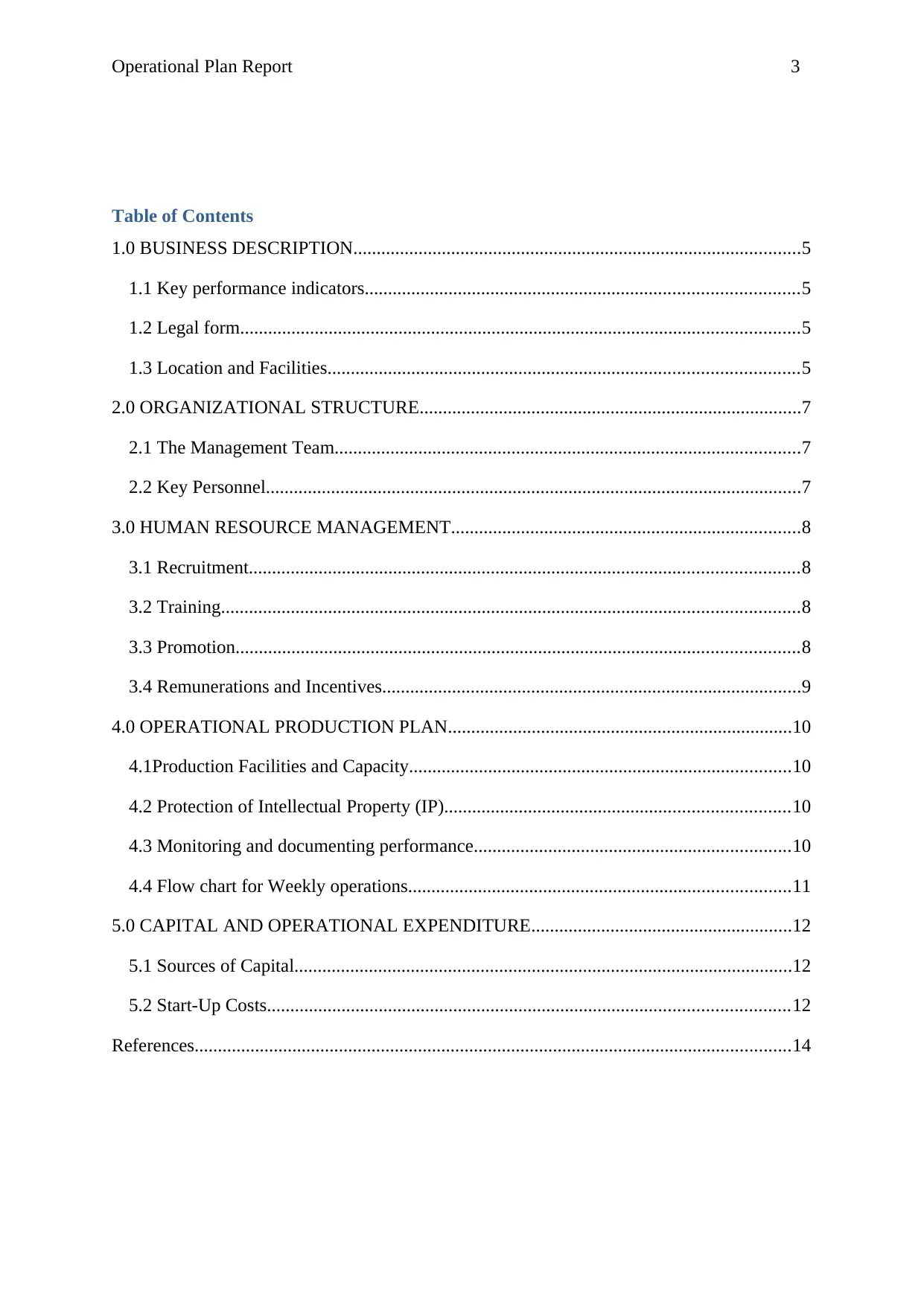
Operational Plan Report 3
Table of Contents
1.0 BUSINESS DESCRIPTION................................................................................................5
1.1 Key performance indicators.............................................................................................5
1.2 Legal form........................................................................................................................5
1.3 Location and Facilities.....................................................................................................5
2.0 ORGANIZATIONAL STRUCTURE..................................................................................7
2.1 The Management Team....................................................................................................7
2.2 Key Personnel...................................................................................................................7
3.0 HUMAN RESOURCE MANAGEMENT...........................................................................8
3.1 Recruitment......................................................................................................................8
3.2 Training............................................................................................................................8
3.3 Promotion.........................................................................................................................8
3.4 Remunerations and Incentives..........................................................................................9
4.0 OPERATIONAL PRODUCTION PLAN..........................................................................10
4.1Production Facilities and Capacity..................................................................................10
4.2 Protection of Intellectual Property (IP)..........................................................................10
4.3 Monitoring and documenting performance....................................................................10
4.4 Flow chart for Weekly operations..................................................................................11
5.0 CAPITAL AND OPERATIONAL EXPENDITURE........................................................12
5.1 Sources of Capital...........................................................................................................12
5.2 Start-Up Costs................................................................................................................12
References................................................................................................................................14
Table of Contents
1.0 BUSINESS DESCRIPTION................................................................................................5
1.1 Key performance indicators.............................................................................................5
1.2 Legal form........................................................................................................................5
1.3 Location and Facilities.....................................................................................................5
2.0 ORGANIZATIONAL STRUCTURE..................................................................................7
2.1 The Management Team....................................................................................................7
2.2 Key Personnel...................................................................................................................7
3.0 HUMAN RESOURCE MANAGEMENT...........................................................................8
3.1 Recruitment......................................................................................................................8
3.2 Training............................................................................................................................8
3.3 Promotion.........................................................................................................................8
3.4 Remunerations and Incentives..........................................................................................9
4.0 OPERATIONAL PRODUCTION PLAN..........................................................................10
4.1Production Facilities and Capacity..................................................................................10
4.2 Protection of Intellectual Property (IP)..........................................................................10
4.3 Monitoring and documenting performance....................................................................10
4.4 Flow chart for Weekly operations..................................................................................11
5.0 CAPITAL AND OPERATIONAL EXPENDITURE........................................................12
5.1 Sources of Capital...........................................................................................................12
5.2 Start-Up Costs................................................................................................................12
References................................................................................................................................14
⊘ This is a preview!⊘
Do you want full access?
Subscribe today to unlock all pages.

Trusted by 1+ million students worldwide
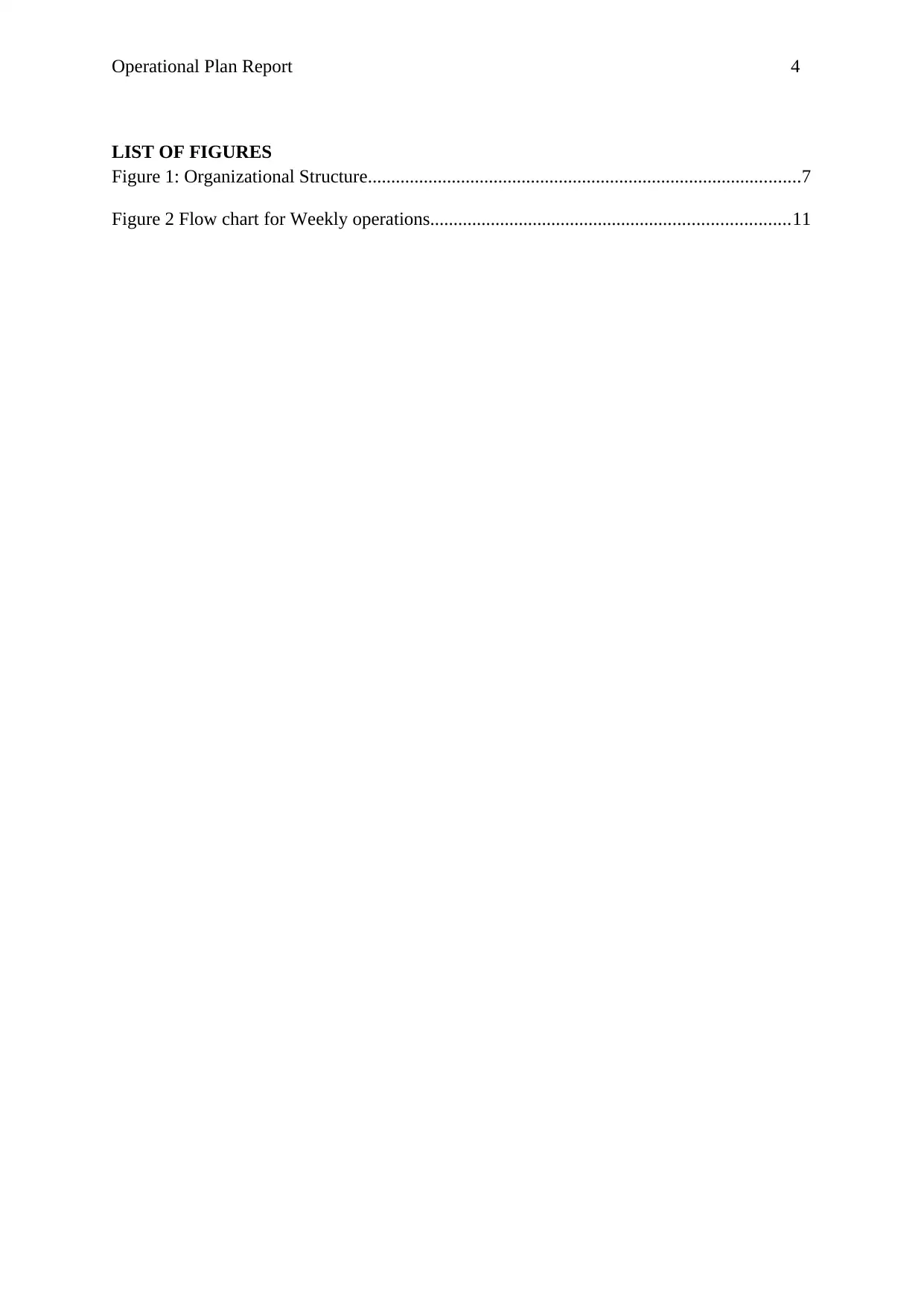
Operational Plan Report 4
LIST OF FIGURES
Figure 1: Organizational Structure.............................................................................................7
Figure 2 Flow chart for Weekly operations.............................................................................11
LIST OF FIGURES
Figure 1: Organizational Structure.............................................................................................7
Figure 2 Flow chart for Weekly operations.............................................................................11
Paraphrase This Document
Need a fresh take? Get an instant paraphrase of this document with our AI Paraphraser
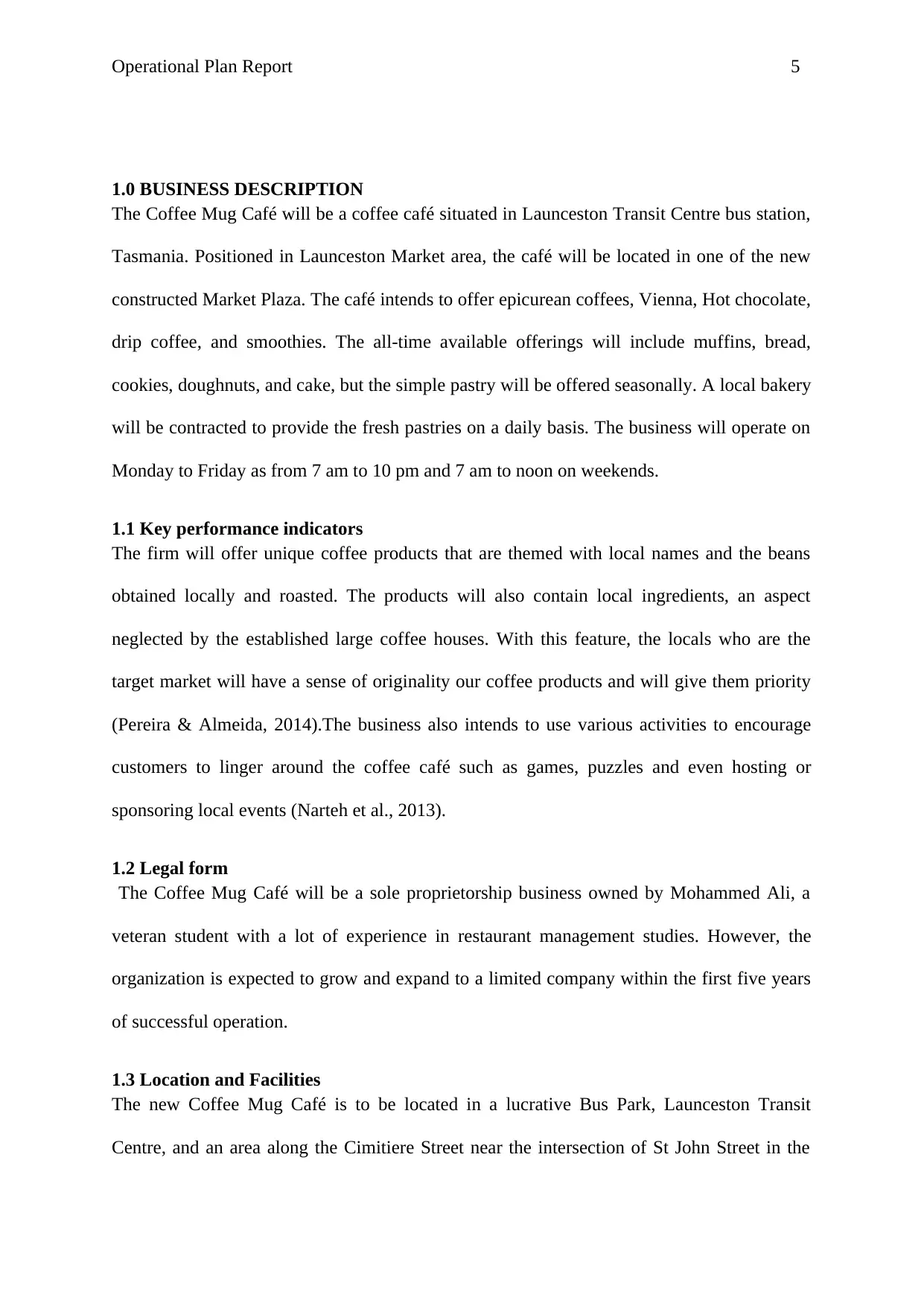
Operational Plan Report 5
1.0 BUSINESS DESCRIPTION
The Coffee Mug Café will be a coffee café situated in Launceston Transit Centre bus station,
Tasmania. Positioned in Launceston Market area, the café will be located in one of the new
constructed Market Plaza. The café intends to offer epicurean coffees, Vienna, Hot chocolate,
drip coffee, and smoothies. The all-time available offerings will include muffins, bread,
cookies, doughnuts, and cake, but the simple pastry will be offered seasonally. A local bakery
will be contracted to provide the fresh pastries on a daily basis. The business will operate on
Monday to Friday as from 7 am to 10 pm and 7 am to noon on weekends.
1.1 Key performance indicators
The firm will offer unique coffee products that are themed with local names and the beans
obtained locally and roasted. The products will also contain local ingredients, an aspect
neglected by the established large coffee houses. With this feature, the locals who are the
target market will have a sense of originality our coffee products and will give them priority
(Pereira & Almeida, 2014).The business also intends to use various activities to encourage
customers to linger around the coffee café such as games, puzzles and even hosting or
sponsoring local events (Narteh et al., 2013).
1.2 Legal form
The Coffee Mug Café will be a sole proprietorship business owned by Mohammed Ali, a
veteran student with a lot of experience in restaurant management studies. However, the
organization is expected to grow and expand to a limited company within the first five years
of successful operation.
1.3 Location and Facilities
The new Coffee Mug Café is to be located in a lucrative Bus Park, Launceston Transit
Centre, and an area along the Cimitiere Street near the intersection of St John Street in the
1.0 BUSINESS DESCRIPTION
The Coffee Mug Café will be a coffee café situated in Launceston Transit Centre bus station,
Tasmania. Positioned in Launceston Market area, the café will be located in one of the new
constructed Market Plaza. The café intends to offer epicurean coffees, Vienna, Hot chocolate,
drip coffee, and smoothies. The all-time available offerings will include muffins, bread,
cookies, doughnuts, and cake, but the simple pastry will be offered seasonally. A local bakery
will be contracted to provide the fresh pastries on a daily basis. The business will operate on
Monday to Friday as from 7 am to 10 pm and 7 am to noon on weekends.
1.1 Key performance indicators
The firm will offer unique coffee products that are themed with local names and the beans
obtained locally and roasted. The products will also contain local ingredients, an aspect
neglected by the established large coffee houses. With this feature, the locals who are the
target market will have a sense of originality our coffee products and will give them priority
(Pereira & Almeida, 2014).The business also intends to use various activities to encourage
customers to linger around the coffee café such as games, puzzles and even hosting or
sponsoring local events (Narteh et al., 2013).
1.2 Legal form
The Coffee Mug Café will be a sole proprietorship business owned by Mohammed Ali, a
veteran student with a lot of experience in restaurant management studies. However, the
organization is expected to grow and expand to a limited company within the first five years
of successful operation.
1.3 Location and Facilities
The new Coffee Mug Café is to be located in a lucrative Bus Park, Launceston Transit
Centre, and an area along the Cimitiere Street near the intersection of St John Street in the
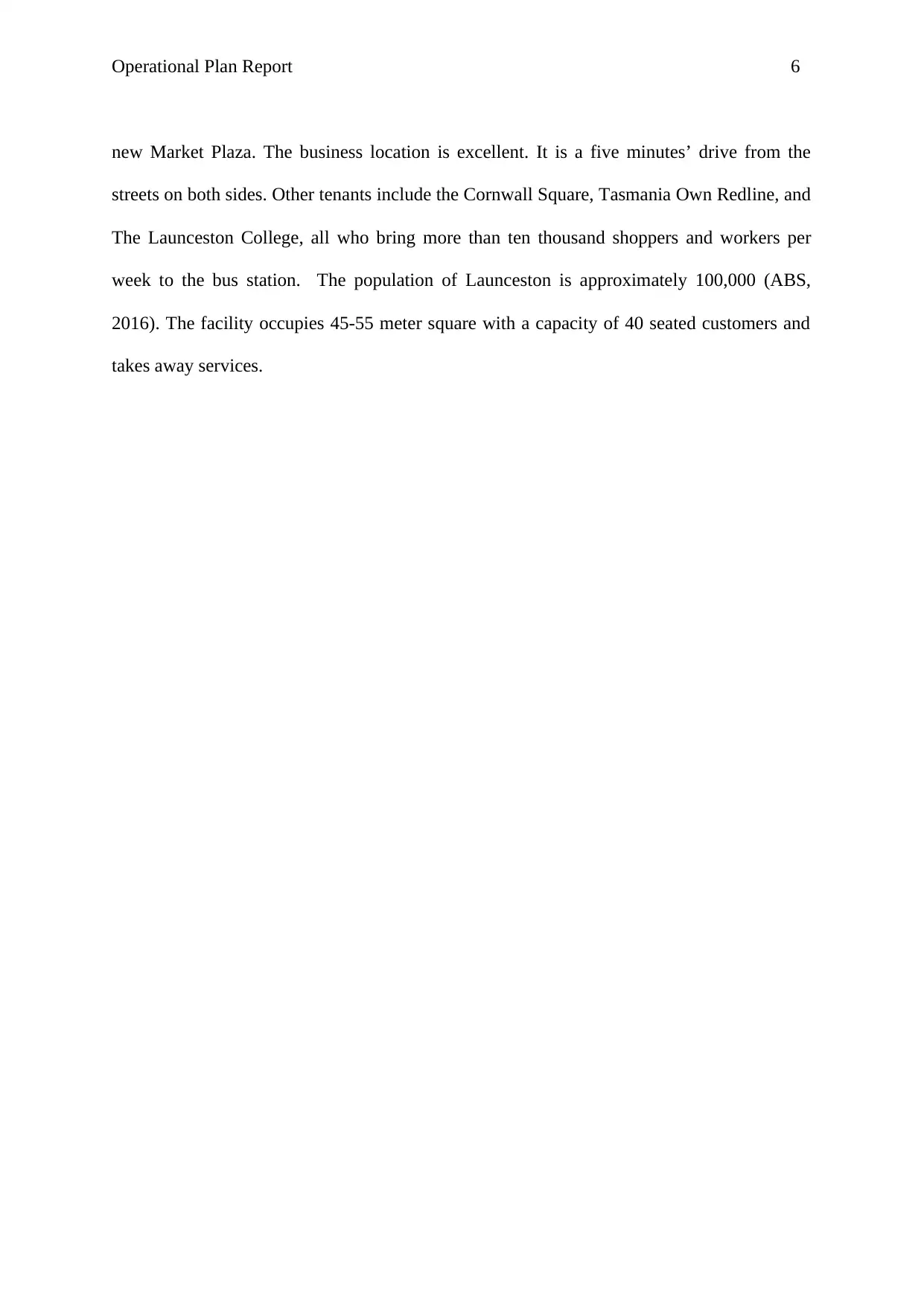
Operational Plan Report 6
new Market Plaza. The business location is excellent. It is a five minutes’ drive from the
streets on both sides. Other tenants include the Cornwall Square, Tasmania Own Redline, and
The Launceston College, all who bring more than ten thousand shoppers and workers per
week to the bus station. The population of Launceston is approximately 100,000 (ABS,
2016). The facility occupies 45-55 meter square with a capacity of 40 seated customers and
takes away services.
new Market Plaza. The business location is excellent. It is a five minutes’ drive from the
streets on both sides. Other tenants include the Cornwall Square, Tasmania Own Redline, and
The Launceston College, all who bring more than ten thousand shoppers and workers per
week to the bus station. The population of Launceston is approximately 100,000 (ABS,
2016). The facility occupies 45-55 meter square with a capacity of 40 seated customers and
takes away services.
⊘ This is a preview!⊘
Do you want full access?
Subscribe today to unlock all pages.

Trusted by 1+ million students worldwide
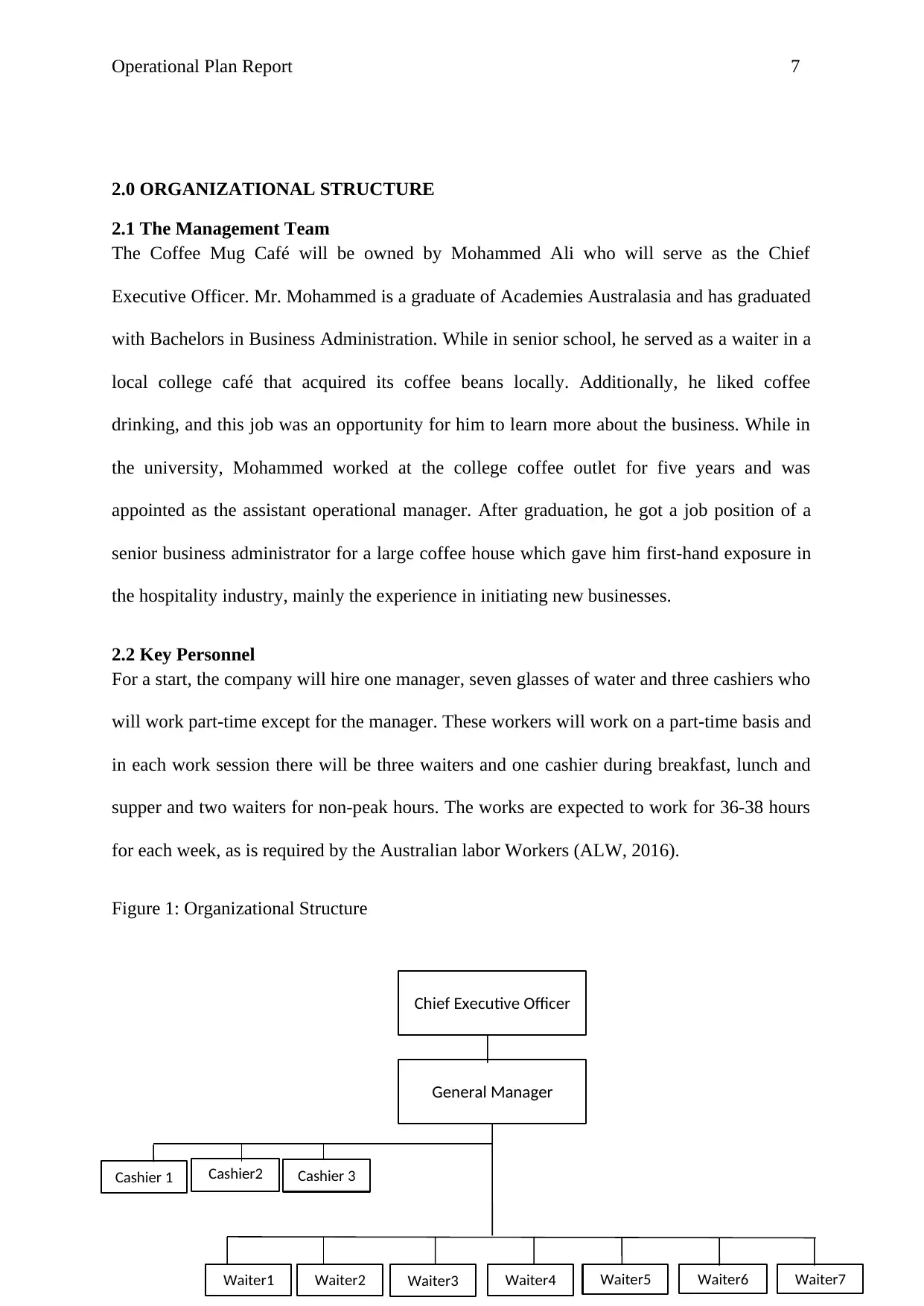
Operational Plan Report 7
2.0 ORGANIZATIONAL STRUCTURE
2.1 The Management Team
The Coffee Mug Café will be owned by Mohammed Ali who will serve as the Chief
Executive Officer. Mr. Mohammed is a graduate of Academies Australasia and has graduated
with Bachelors in Business Administration. While in senior school, he served as a waiter in a
local college café that acquired its coffee beans locally. Additionally, he liked coffee
drinking, and this job was an opportunity for him to learn more about the business. While in
the university, Mohammed worked at the college coffee outlet for five years and was
appointed as the assistant operational manager. After graduation, he got a job position of a
senior business administrator for a large coffee house which gave him first-hand exposure in
the hospitality industry, mainly the experience in initiating new businesses.
2.2 Key Personnel
For a start, the company will hire one manager, seven glasses of water and three cashiers who
will work part-time except for the manager. These workers will work on a part-time basis and
in each work session there will be three waiters and one cashier during breakfast, lunch and
supper and two waiters for non-peak hours. The works are expected to work for 36-38 hours
for each week, as is required by the Australian labor Workers (ALW, 2016).
Figure 1: Organizational Structure
Figure 1Figure 1: Organizational Structure
Chief Executive Officer
Cashier 3Cashier2
22
Cashier 1
General Manager
Waiter2Waiter1 Waiter7Waiter5 Waiter6Waiter4Waiter3
2.0 ORGANIZATIONAL STRUCTURE
2.1 The Management Team
The Coffee Mug Café will be owned by Mohammed Ali who will serve as the Chief
Executive Officer. Mr. Mohammed is a graduate of Academies Australasia and has graduated
with Bachelors in Business Administration. While in senior school, he served as a waiter in a
local college café that acquired its coffee beans locally. Additionally, he liked coffee
drinking, and this job was an opportunity for him to learn more about the business. While in
the university, Mohammed worked at the college coffee outlet for five years and was
appointed as the assistant operational manager. After graduation, he got a job position of a
senior business administrator for a large coffee house which gave him first-hand exposure in
the hospitality industry, mainly the experience in initiating new businesses.
2.2 Key Personnel
For a start, the company will hire one manager, seven glasses of water and three cashiers who
will work part-time except for the manager. These workers will work on a part-time basis and
in each work session there will be three waiters and one cashier during breakfast, lunch and
supper and two waiters for non-peak hours. The works are expected to work for 36-38 hours
for each week, as is required by the Australian labor Workers (ALW, 2016).
Figure 1: Organizational Structure
Figure 1Figure 1: Organizational Structure
Chief Executive Officer
Cashier 3Cashier2
22
Cashier 1
General Manager
Waiter2Waiter1 Waiter7Waiter5 Waiter6Waiter4Waiter3
Paraphrase This Document
Need a fresh take? Get an instant paraphrase of this document with our AI Paraphraser
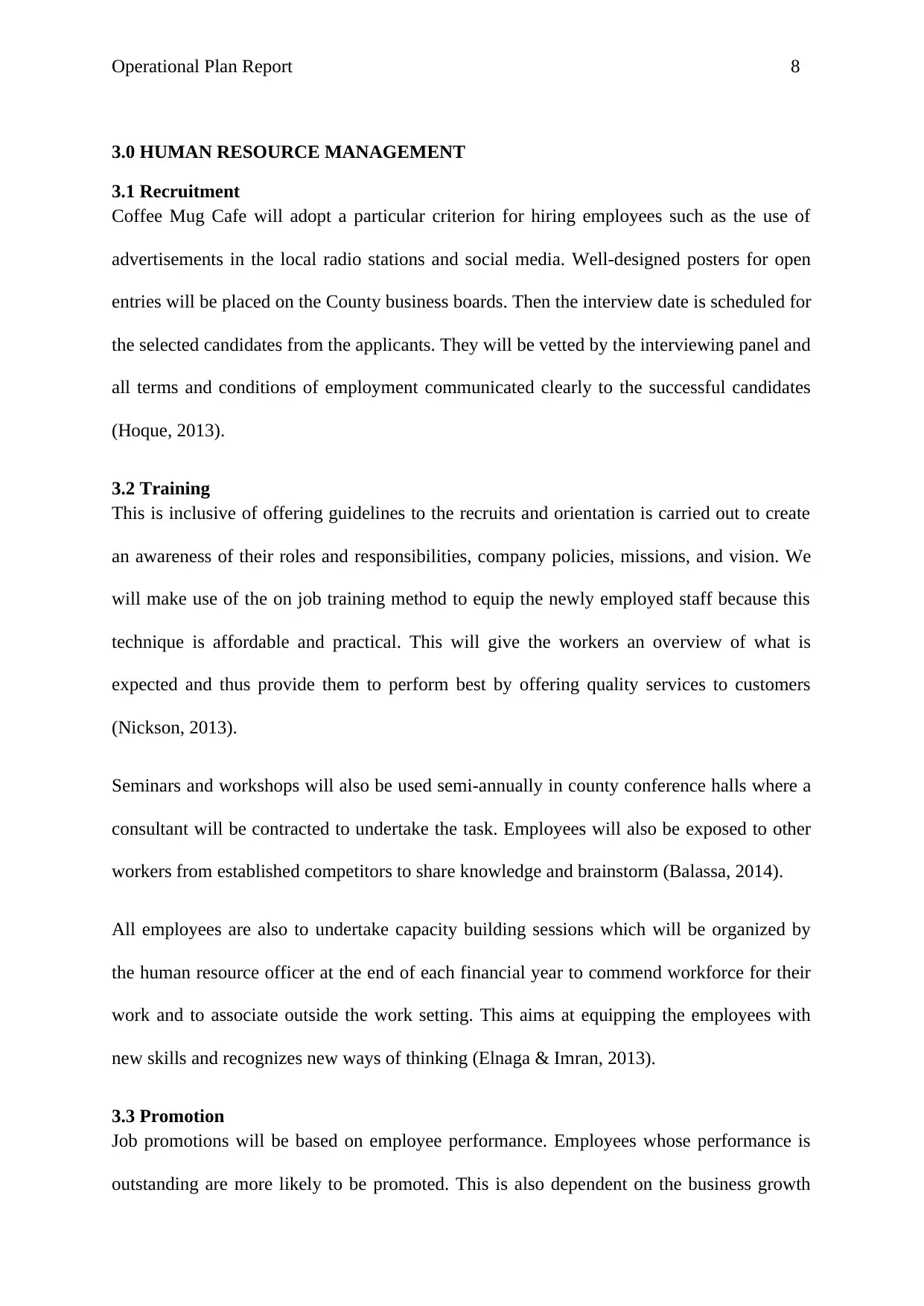
Operational Plan Report 8
3.0 HUMAN RESOURCE MANAGEMENT
3.1 Recruitment
Coffee Mug Cafe will adopt a particular criterion for hiring employees such as the use of
advertisements in the local radio stations and social media. Well-designed posters for open
entries will be placed on the County business boards. Then the interview date is scheduled for
the selected candidates from the applicants. They will be vetted by the interviewing panel and
all terms and conditions of employment communicated clearly to the successful candidates
(Hoque, 2013).
3.2 Training
This is inclusive of offering guidelines to the recruits and orientation is carried out to create
an awareness of their roles and responsibilities, company policies, missions, and vision. We
will make use of the on job training method to equip the newly employed staff because this
technique is affordable and practical. This will give the workers an overview of what is
expected and thus provide them to perform best by offering quality services to customers
(Nickson, 2013).
Seminars and workshops will also be used semi-annually in county conference halls where a
consultant will be contracted to undertake the task. Employees will also be exposed to other
workers from established competitors to share knowledge and brainstorm (Balassa, 2014).
All employees are also to undertake capacity building sessions which will be organized by
the human resource officer at the end of each financial year to commend workforce for their
work and to associate outside the work setting. This aims at equipping the employees with
new skills and recognizes new ways of thinking (Elnaga & Imran, 2013).
3.3 Promotion
Job promotions will be based on employee performance. Employees whose performance is
outstanding are more likely to be promoted. This is also dependent on the business growth
3.0 HUMAN RESOURCE MANAGEMENT
3.1 Recruitment
Coffee Mug Cafe will adopt a particular criterion for hiring employees such as the use of
advertisements in the local radio stations and social media. Well-designed posters for open
entries will be placed on the County business boards. Then the interview date is scheduled for
the selected candidates from the applicants. They will be vetted by the interviewing panel and
all terms and conditions of employment communicated clearly to the successful candidates
(Hoque, 2013).
3.2 Training
This is inclusive of offering guidelines to the recruits and orientation is carried out to create
an awareness of their roles and responsibilities, company policies, missions, and vision. We
will make use of the on job training method to equip the newly employed staff because this
technique is affordable and practical. This will give the workers an overview of what is
expected and thus provide them to perform best by offering quality services to customers
(Nickson, 2013).
Seminars and workshops will also be used semi-annually in county conference halls where a
consultant will be contracted to undertake the task. Employees will also be exposed to other
workers from established competitors to share knowledge and brainstorm (Balassa, 2014).
All employees are also to undertake capacity building sessions which will be organized by
the human resource officer at the end of each financial year to commend workforce for their
work and to associate outside the work setting. This aims at equipping the employees with
new skills and recognizes new ways of thinking (Elnaga & Imran, 2013).
3.3 Promotion
Job promotions will be based on employee performance. Employees whose performance is
outstanding are more likely to be promoted. This is also dependent on the business growth
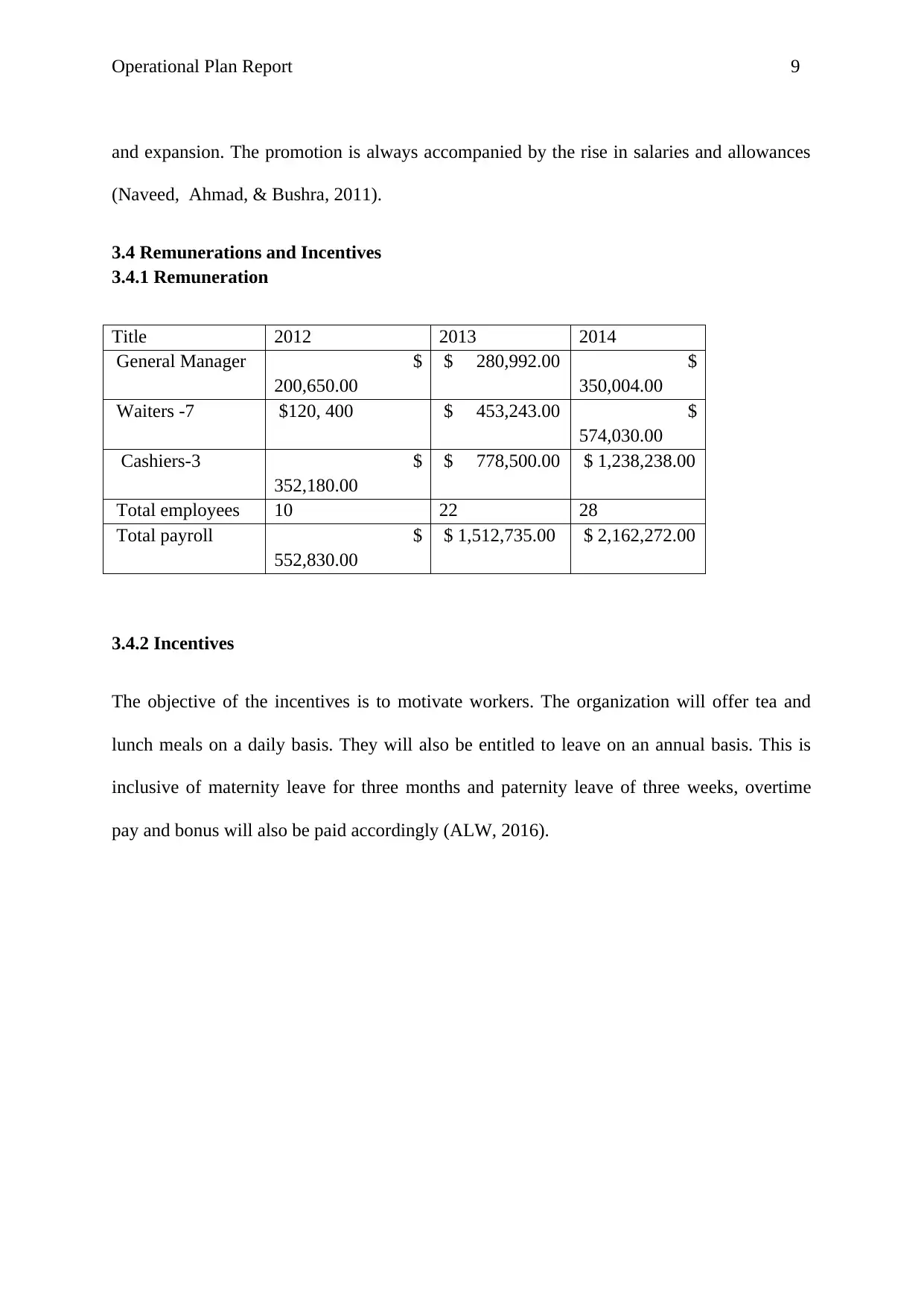
Operational Plan Report 9
and expansion. The promotion is always accompanied by the rise in salaries and allowances
(Naveed, Ahmad, & Bushra, 2011).
3.4 Remunerations and Incentives
3.4.1 Remuneration
Title 2012 2013 2014
General Manager $
200,650.00
$ 280,992.00 $
350,004.00
Waiters -7 $120, 400 $ 453,243.00 $
574,030.00
Cashiers-3 $
352,180.00
$ 778,500.00 $ 1,238,238.00
Total employees 10 22 28
Total payroll $
552,830.00
$ 1,512,735.00 $ 2,162,272.00
3.4.2 Incentives
The objective of the incentives is to motivate workers. The organization will offer tea and
lunch meals on a daily basis. They will also be entitled to leave on an annual basis. This is
inclusive of maternity leave for three months and paternity leave of three weeks, overtime
pay and bonus will also be paid accordingly (ALW, 2016).
and expansion. The promotion is always accompanied by the rise in salaries and allowances
(Naveed, Ahmad, & Bushra, 2011).
3.4 Remunerations and Incentives
3.4.1 Remuneration
Title 2012 2013 2014
General Manager $
200,650.00
$ 280,992.00 $
350,004.00
Waiters -7 $120, 400 $ 453,243.00 $
574,030.00
Cashiers-3 $
352,180.00
$ 778,500.00 $ 1,238,238.00
Total employees 10 22 28
Total payroll $
552,830.00
$ 1,512,735.00 $ 2,162,272.00
3.4.2 Incentives
The objective of the incentives is to motivate workers. The organization will offer tea and
lunch meals on a daily basis. They will also be entitled to leave on an annual basis. This is
inclusive of maternity leave for three months and paternity leave of three weeks, overtime
pay and bonus will also be paid accordingly (ALW, 2016).
⊘ This is a preview!⊘
Do you want full access?
Subscribe today to unlock all pages.

Trusted by 1+ million students worldwide
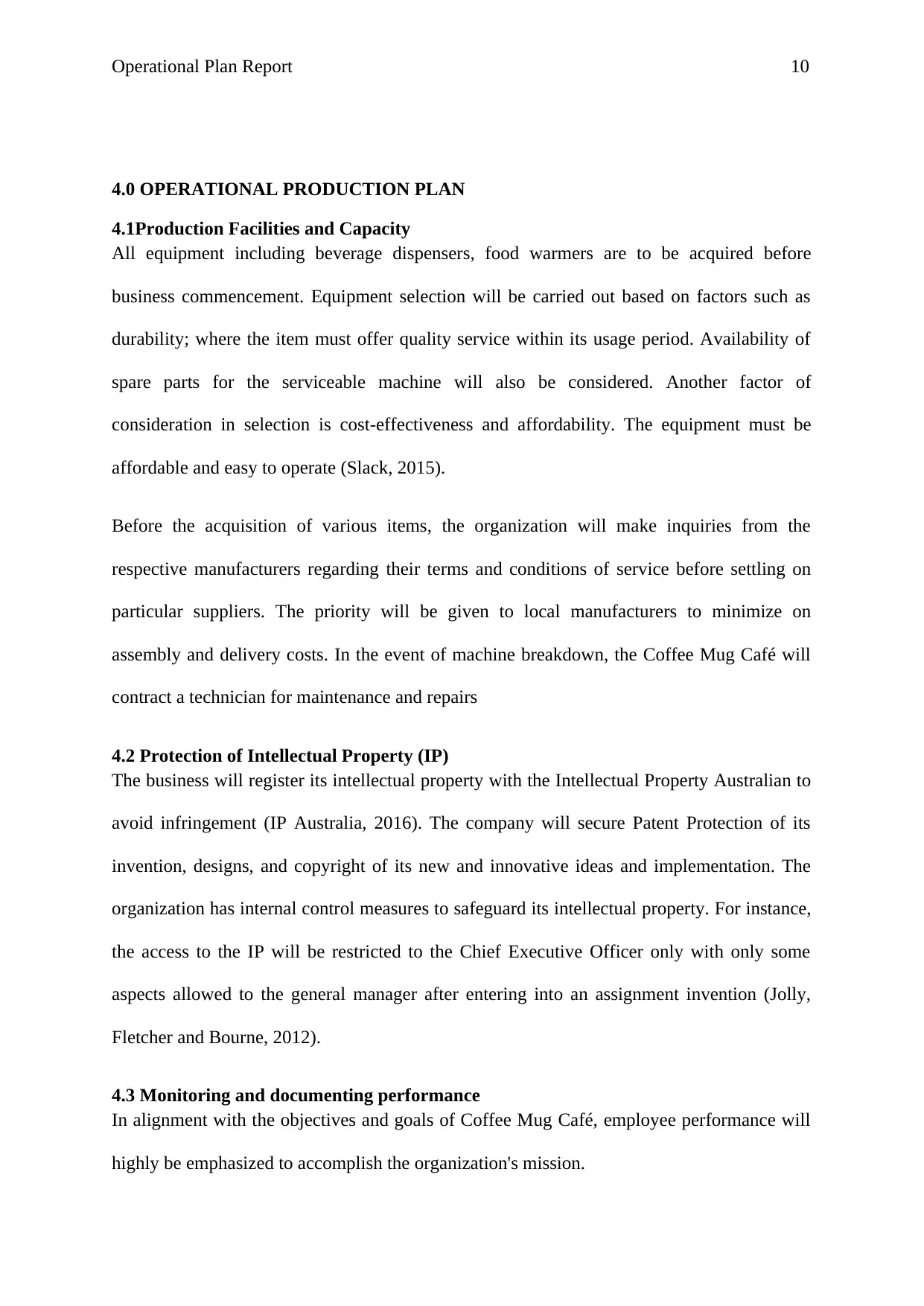
Operational Plan Report 10
4.0 OPERATIONAL PRODUCTION PLAN
4.1Production Facilities and Capacity
All equipment including beverage dispensers, food warmers are to be acquired before
business commencement. Equipment selection will be carried out based on factors such as
durability; where the item must offer quality service within its usage period. Availability of
spare parts for the serviceable machine will also be considered. Another factor of
consideration in selection is cost-effectiveness and affordability. The equipment must be
affordable and easy to operate (Slack, 2015).
Before the acquisition of various items, the organization will make inquiries from the
respective manufacturers regarding their terms and conditions of service before settling on
particular suppliers. The priority will be given to local manufacturers to minimize on
assembly and delivery costs. In the event of machine breakdown, the Coffee Mug Café will
contract a technician for maintenance and repairs
4.2 Protection of Intellectual Property (IP)
The business will register its intellectual property with the Intellectual Property Australian to
avoid infringement (IP Australia, 2016). The company will secure Patent Protection of its
invention, designs, and copyright of its new and innovative ideas and implementation. The
organization has internal control measures to safeguard its intellectual property. For instance,
the access to the IP will be restricted to the Chief Executive Officer only with only some
aspects allowed to the general manager after entering into an assignment invention (Jolly,
Fletcher and Bourne, 2012).
4.3 Monitoring and documenting performance
In alignment with the objectives and goals of Coffee Mug Café, employee performance will
highly be emphasized to accomplish the organization's mission.
4.0 OPERATIONAL PRODUCTION PLAN
4.1Production Facilities and Capacity
All equipment including beverage dispensers, food warmers are to be acquired before
business commencement. Equipment selection will be carried out based on factors such as
durability; where the item must offer quality service within its usage period. Availability of
spare parts for the serviceable machine will also be considered. Another factor of
consideration in selection is cost-effectiveness and affordability. The equipment must be
affordable and easy to operate (Slack, 2015).
Before the acquisition of various items, the organization will make inquiries from the
respective manufacturers regarding their terms and conditions of service before settling on
particular suppliers. The priority will be given to local manufacturers to minimize on
assembly and delivery costs. In the event of machine breakdown, the Coffee Mug Café will
contract a technician for maintenance and repairs
4.2 Protection of Intellectual Property (IP)
The business will register its intellectual property with the Intellectual Property Australian to
avoid infringement (IP Australia, 2016). The company will secure Patent Protection of its
invention, designs, and copyright of its new and innovative ideas and implementation. The
organization has internal control measures to safeguard its intellectual property. For instance,
the access to the IP will be restricted to the Chief Executive Officer only with only some
aspects allowed to the general manager after entering into an assignment invention (Jolly,
Fletcher and Bourne, 2012).
4.3 Monitoring and documenting performance
In alignment with the objectives and goals of Coffee Mug Café, employee performance will
highly be emphasized to accomplish the organization's mission.
Paraphrase This Document
Need a fresh take? Get an instant paraphrase of this document with our AI Paraphraser
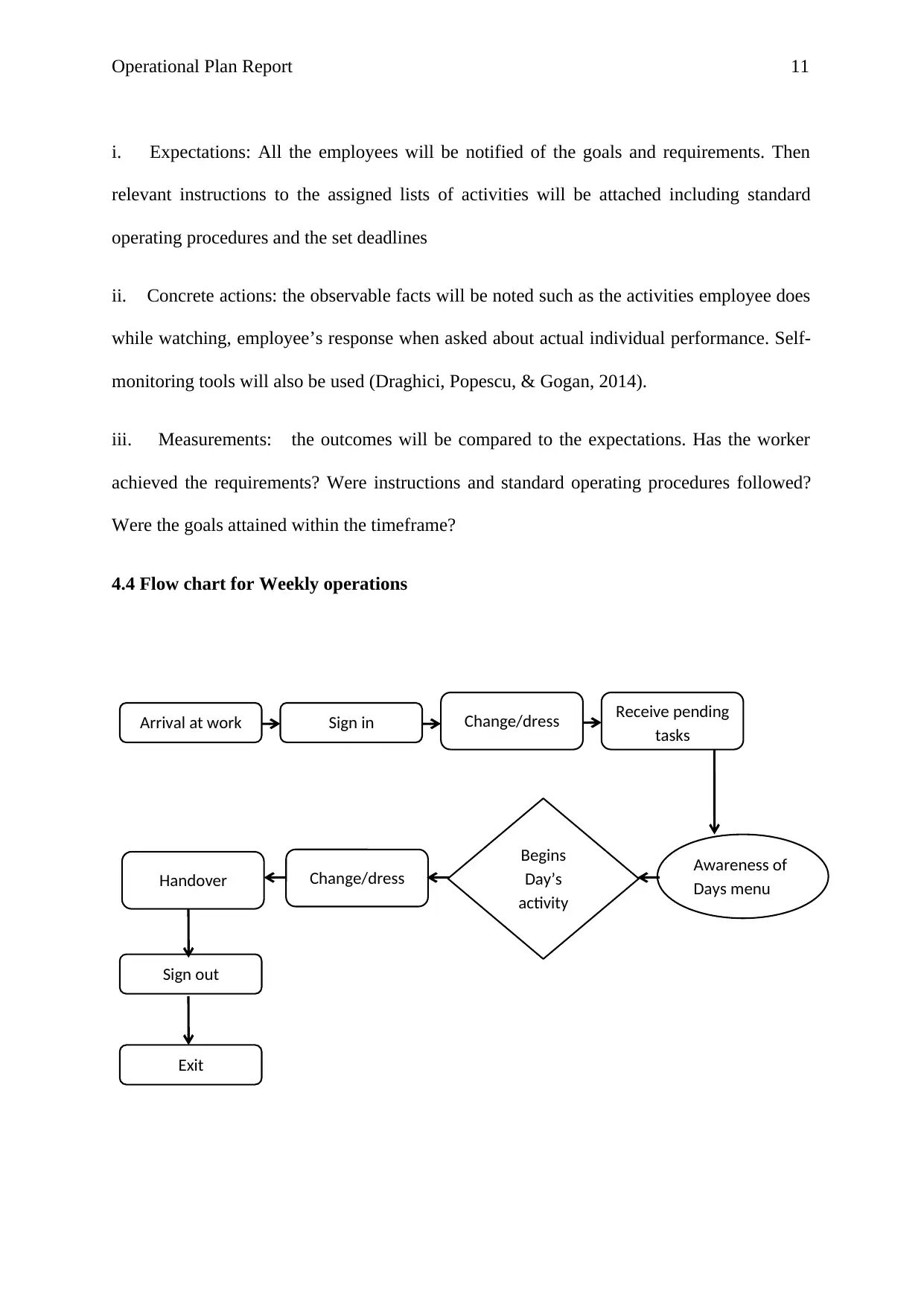
Operational Plan Report 11
i. Expectations: All the employees will be notified of the goals and requirements. Then
relevant instructions to the assigned lists of activities will be attached including standard
operating procedures and the set deadlines
ii. Concrete actions: the observable facts will be noted such as the activities employee does
while watching, employee’s response when asked about actual individual performance. Self-
monitoring tools will also be used (Draghici, Popescu, & Gogan, 2014).
iii. Measurements: the outcomes will be compared to the expectations. Has the worker
achieved the requirements? Were instructions and standard operating procedures followed?
Were the goals attained within the timeframe?
4.4 Flow chart for Weekly operations
Figure 2Flow chart for Weekly operations
Exit
Sign out
Handover Change/dress
Begins
Day’s
activity
Awareness of
Days menu
Receive pending
tasks
Change/dressSign inArrival at work
i. Expectations: All the employees will be notified of the goals and requirements. Then
relevant instructions to the assigned lists of activities will be attached including standard
operating procedures and the set deadlines
ii. Concrete actions: the observable facts will be noted such as the activities employee does
while watching, employee’s response when asked about actual individual performance. Self-
monitoring tools will also be used (Draghici, Popescu, & Gogan, 2014).
iii. Measurements: the outcomes will be compared to the expectations. Has the worker
achieved the requirements? Were instructions and standard operating procedures followed?
Were the goals attained within the timeframe?
4.4 Flow chart for Weekly operations
Figure 2Flow chart for Weekly operations
Exit
Sign out
Handover Change/dress
Begins
Day’s
activity
Awareness of
Days menu
Receive pending
tasks
Change/dressSign inArrival at work
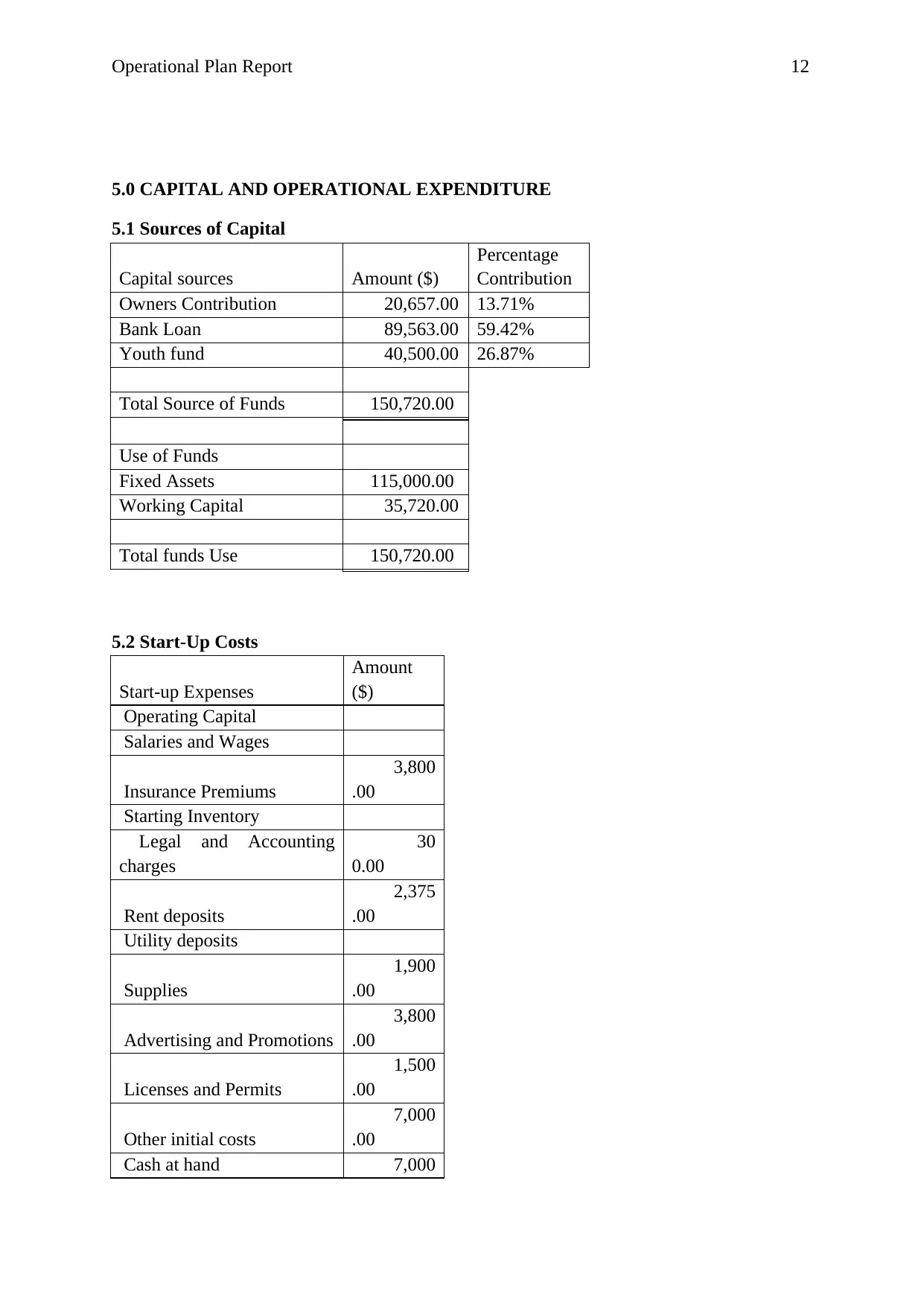
Operational Plan Report 12
5.0 CAPITAL AND OPERATIONAL EXPENDITURE
5.1 Sources of Capital
Capital sources Amount ($)
Percentage
Contribution
Owners Contribution 20,657.00 13.71%
Bank Loan 89,563.00 59.42%
Youth fund 40,500.00 26.87%
Total Source of Funds 150,720.00
Use of Funds
Fixed Assets 115,000.00
Working Capital 35,720.00
Total funds Use 150,720.00
5.2 Start-Up Costs
Start-up Expenses
Amount
($)
Operating Capital
Salaries and Wages
Insurance Premiums
3,800
.00
Starting Inventory
Legal and Accounting
charges
30
0.00
Rent deposits
2,375
.00
Utility deposits
Supplies
1,900
.00
Advertising and Promotions
3,800
.00
Licenses and Permits
1,500
.00
Other initial costs
7,000
.00
Cash at hand 7,000
5.0 CAPITAL AND OPERATIONAL EXPENDITURE
5.1 Sources of Capital
Capital sources Amount ($)
Percentage
Contribution
Owners Contribution 20,657.00 13.71%
Bank Loan 89,563.00 59.42%
Youth fund 40,500.00 26.87%
Total Source of Funds 150,720.00
Use of Funds
Fixed Assets 115,000.00
Working Capital 35,720.00
Total funds Use 150,720.00
5.2 Start-Up Costs
Start-up Expenses
Amount
($)
Operating Capital
Salaries and Wages
Insurance Premiums
3,800
.00
Starting Inventory
Legal and Accounting
charges
30
0.00
Rent deposits
2,375
.00
Utility deposits
Supplies
1,900
.00
Advertising and Promotions
3,800
.00
Licenses and Permits
1,500
.00
Other initial costs
7,000
.00
Cash at hand 7,000
⊘ This is a preview!⊘
Do you want full access?
Subscribe today to unlock all pages.

Trusted by 1+ million students worldwide
1 out of 15
Your All-in-One AI-Powered Toolkit for Academic Success.
+13062052269
info@desklib.com
Available 24*7 on WhatsApp / Email
![[object Object]](/_next/static/media/star-bottom.7253800d.svg)
Unlock your academic potential
Copyright © 2020–2025 A2Z Services. All Rights Reserved. Developed and managed by ZUCOL.
